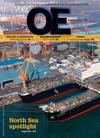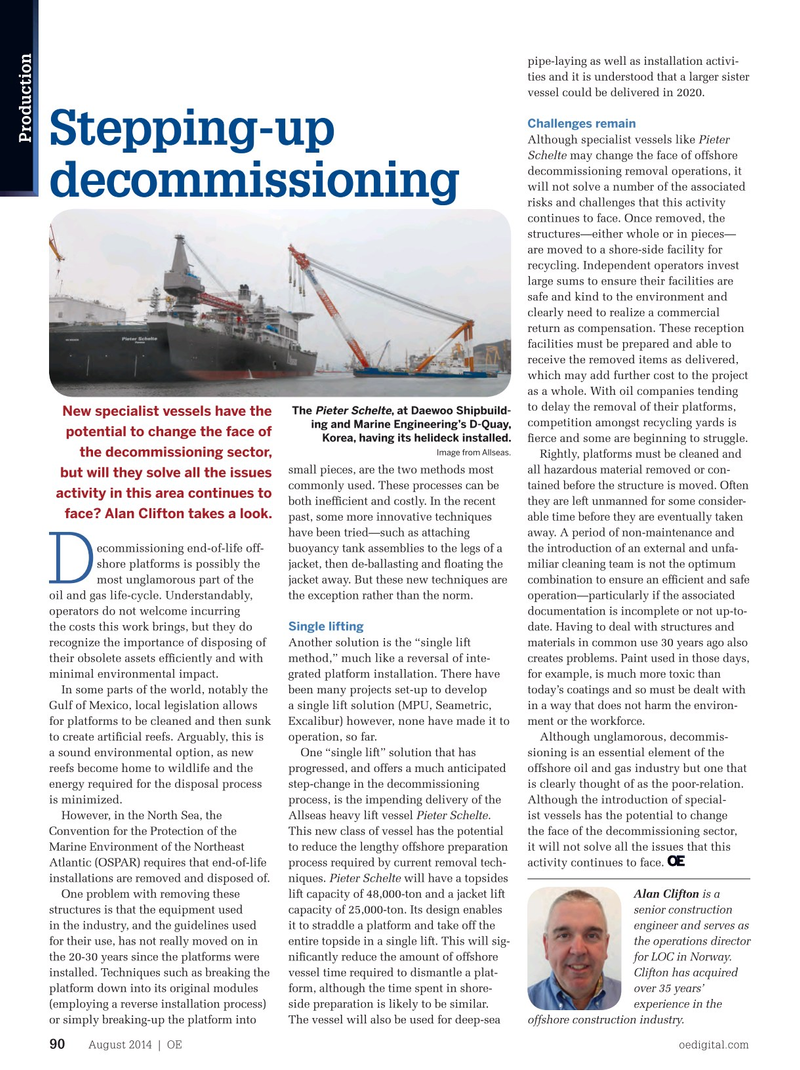
Page 88: of Offshore Engineer Magazine (Aug/Sep 2014)
Read this page in Pdf, Flash or Html5 edition of Aug/Sep 2014 Offshore Engineer Magazine
pipe-laying as well as installation activi- ties and it is understood that a larger sister vessel could be delivered in 2020.
Challenges remain
EyebrowProduction
Although specialist vessels like Pieter
Stepping-up
Schelte may change the face of offshore decommissioning removal operations, it will not solve a number of the associated decommissioning risks and challenges that this activity continues to face. Once removed, the structures—either whole or in pieces— are moved to a shore-side facility for recycling. Independent operators invest large sums to ensure their facilities are safe and kind to the environment and clearly need to realize a commercial return as compensation. These reception facilities must be prepared and able to receive the removed items as delivered, which may add further cost to the project as a whole. With oil companies tending to delay the removal of their platforms,
The , at Daewoo Shipbuild- Pieter Schelte
New specialist vessels have the competition amongst recycling yards is ing and Marine Engineering’s D-Quay, potential to change the face of
Korea, having its helideck installed. ferce and some are beginning to struggle.
Image from Allseas.
the decommissioning sector,
Rightly, platforms must be cleaned and all hazardous material removed or con- small pieces, are the two methods most but will they solve all the issues tained before the structure is moved. Often commonly used. These processes can be activity in this area continues to they are left unmanned for some consider- both ineffcient and costly. In the recent face? Alan Clifton takes a look. able time before they are eventually taken past, some more innovative techniques away. A period of non-maintenance and have been tried—such as attaching ecommissioning end-of-life off- buoyancy tank assemblies to the legs of a the introduction of an external and unfa- shore platforms is possibly the jacket, then de-ballasting and foating the miliar cleaning team is not the optimum
D most unglamorous part of the jacket away. But these new techniques are combination to ensure an effcient and safe operation—particularly if the associated oil and gas life-cycle. Understandably, the exception rather than the norm. documentation is incomplete or not up-to- operators do not welcome incurring
Single lifting date. Having to deal with structures and the costs this work brings, but they do materials in common use 30 years ago also recognize the importance of disposing of Another solution is the “single lift creates problems. Paint used in those days, their obsolete assets effciently and with method,” much like a reversal of inte- for example, is much more toxic than minimal environmental impact. grated platform installation. There have today’s coatings and so must be dealt with
In some parts of the world, notably the been many projects set-up to develop in a way that does not harm the environ-
Gulf of Mexico, local legislation allows a single lift solution (MPU, Seametric, ment or the workforce.
for platforms to be cleaned and then sunk Excalibur) however, none have made it to to create artifcial reefs. Arguably, this is operation, so far. Although unglamorous, decommis- a sound environmental option, as new One “single lift” solution that has sioning is an essential element of the reefs become home to wildlife and the progressed, and offers a much anticipated offshore oil and gas industry but one that energy required for the disposal process step-change in the decommissioning is clearly thought of as the poor-relation. is minimized. process, is the impending delivery of the Although the introduction of special-
However, in the North Sea, the Allseas heavy lift vessel Pieter Schelte. ist vessels has the potential to change
Convention for the Protection of the This new class of vessel has the potential the face of the decommissioning sector,
Marine Environment of the Northeast to reduce the lengthy offshore preparation it will not solve all the issues that this
Atlantic (OSPAR) requires that end-of-life process required by current removal tech- activity continues to face. installations are removed and disposed of. niques. Pieter Schelte will have a topsides
Alan Clifton is a
One problem with removing these lift capacity of 48,000-ton and a jacket lift senior construction structures is that the equipment used capacity of 25,000-ton. Its design enables engineer and serves as in the industry, and the guidelines used it to straddle a platform and take off the the operations director for their use, has not really moved on in entire topside in a single lift. This will sig- for LOC in Norway. the 20-30 years since the platforms were nifcantly reduce the amount of offshore
Clifton has acquired installed. Techniques such as breaking the vessel time required to dismantle a plat- over 35 years’ platform down into its original modules form, although the time spent in shore- experience in the (employing a reverse installation process) side preparation is likely to be similar. offshore construction industry. or simply breaking-up the platform into The vessel will also be used for deep-sea
August 2014 | OE oedigital.com 90 000_OE0814_ProdOps4_LOC.indd 90 7/23/14 12:49 AM

 87
87

 89
89